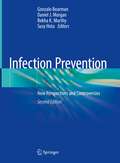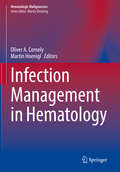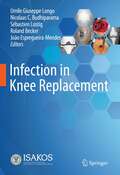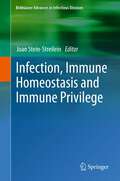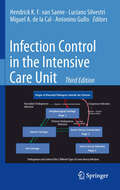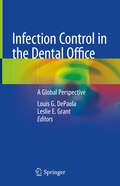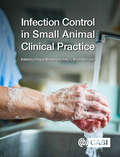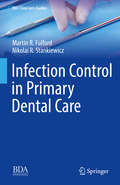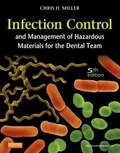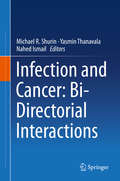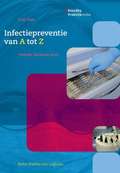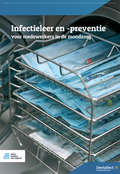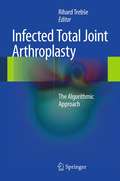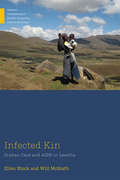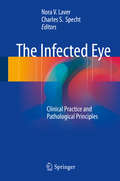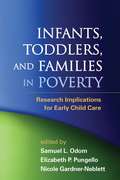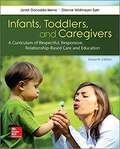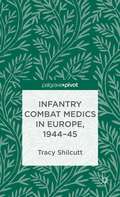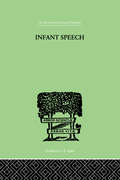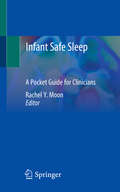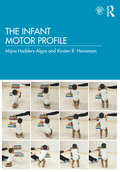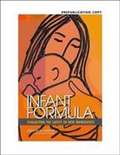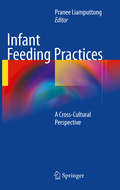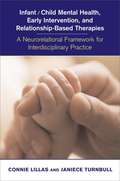- Table View
- List View
Infection Prevention: New Perspectives and Controversies
by Gonzalo Bearman Daniel J. Morgan Rekha K. Murthy Susy HotaThe first edition of Infection Prevention reviewed evolving areas in infection prevention on topics including contact precautions, technology implementation, specific infections, and care in various settings. It summarized the current data on infection prevention, presents controversies on the various topics, and includes recommendations for patient safety. Addressing hot topics such as MRSA, C. difficile vaccination, mandatory flu vaccines, and CLABSI, this is the only text to include prevention and control overviews across a range of infection issues. Written by experts in the field, this successor edition will update current chapters on the most cutting-edge models of care on emerging and evolving topics in infectious diseases. It will also include new material and chapters on high-level disinfection, diagnostic test stewardship, unique pathogens units, outpatient antibiotic stewardship, outpatient antibiotic therapy, as well as a chapter on infection prevention metrics: how much can we prevent healthcare associated infections and how hard should we try. The second edition of Infection Prevention: New Perspectives and Controversies is a valuable resource for infection prevention professionals, healthcare quality and safety professionals, caring for patients in in- and outpatient settings.
Infection Management in Hematology (Hematologic Malignancies)
by Oliver A. Cornely Martin HoeniglThis book provides a thorough update on the management of infections in patients with hematologic malignancies, focusing particularly on prevention, diagnosis, and treatment. Detailed attention is devoted to the central roles that vaccination and anti-infective prophylaxis have gained in improving overall survival in this patient group, in accordance with the principle that prevention is better than cure. Careful consideration is also paid to risk stratification, which is crucial in ensuring that anti-infective prophylaxis is targeted to those at the highest risk. While preventive strategies reduce the prevalence of infections, optimized management strategies are vital to decrease infection-related morbidity and mortality in those who nevertheless develop infections. Here, readers will find in-depth, up-to-date knowledge on the diagnosis and treatment of bacterial, fungal, viral, and parasitic infections, according to the affected organ and the causative pathogen. Finally, treatment in intensive care units is reviewed. The book will be of high value for hematologists, oncologists, and infection specialists.
Infection in Knee Replacement
by Umile Giuseppe Longo Nicolaas C. Budhiparama Sébastien Lustig Roland Becker João Espregueira-MendesThis book provides an in-depth overview of the aetiology, treatment and prevention of infections following knee arthroplasty. It presents up-to-date information on available techniques and salvage procedures for complex patients with infected, total knee arthroplasty.Divided into 5 sections, this book explores biomaterials, clinical manifestations, diagnosis, treatment and prevention, including preoperative optimisation, in order to reduce knee infections. This book is a valuable reference resource for practicing orthopaedic surgeons, residents, and medical students wishing to understand the fundamental concepts in infectious disease medicine needed in current orthopaedic practice.
Infection, Immune Homeostasis and Immune Privilege
by Joan Stein-StreileinOrgans and tissues that can tolerate little or no inflammation have developed multiple overlapping mechanisms of immune protection in the absence of inflammation. These areas have been designated "immune-privileged sites" by Peter Medawar and include the central nervous system, eye, reproductive tract, testis and possibly the liver. Mechanisms of immune homeostasis found in less immune-regulated organs are often evident in the immune privileged sites and vice versa. It is important that the non-inflammatory mechanisms that contribute to immune privilege allow host defense against infectious organisms. This volume highlights the mechanisms leading to immune privilege in tissues and organs, the deviation of immune responses and the modification of the behavior of the immune cells that manage to cross the blood barriers of tissues, in the context of infection.
Infection Control in the Intensive Care Unit
by Antonino Gullo Luciano Silvestri Miguel A. Cal Hendrick K.F. SaeneIntensive care is a rapidly changing area of medicine, and after four years from the 2nd edition the volume editors and authors have deemed necessary to update it. In the recent years, in fact, five new randomised controlled trials and five new meta-analyses demonstrate that selective decontamination of the digestive tract [SDD] is an antimicrobial prophylaxis to prevent severe infections of not only lower airways but also of blood. Additionally, SDD has been shown to reduce inflammation including multiple organ failure and mortality. An intriguing observation is the evidence that SDD using parenteral and enteral antimicrobials reduces rather than increases antimicrobial resistance. Moreover, a new chapter on microcirculation had been added. The volume will be an invaluable tool for all those requiring in depth knowledge in the ever expanding field of infection control.
Infection Control in the Dental Office: A Global Perspective
by Louis G. DePaola Leslie E. GrantThis book reviews the principles of infection control and the guidelines and standards of care in multiple countries, discussing them within the context of the practice of dentistry. The aim is to enable dental practitioners to ensure that the appropriate measures are adopted for each patient contact, thereby minimizing the risk of transmission of infection – a goal that is becoming ever more important given the threats posed by new or re-emerging infectious diseases and drug-resistant infections. Readers will find information and guidance on all aspects of infection control within the dental office: hand and respiratory hygiene, use of personal protective equipment, safe handling of sharps and safe injection practices, management of occupational exposures, maintenance of dental unit water quality, surface disinfection, and the cleaning and sterilization of dental instruments. Infection Control in the Dental Office will be an invaluable asset for all dental practitioners, including dentists, dental specialists, dental hygienists, and dental assistants.
Infection Control in Small Animal Clinical Practice
by Lindsey Ashburner Craig R. Breheny Jocelyn Bisson Caitlin Forbes Sian-Marie Frosini Andrew Gardiner Owen Glenn Rosanne Jepson Brandy A. Burgess Rungtip Chuanchuen Martyna Godniak Emily Gorman Eleanor Haskey Thawanrut Kiatyingangsulee Steven Murphy Tim Nuttall Lucas Pantaleon Kathryn Pratschke Alan D. Radford Tom Reilly Mellora Sharman Helen Silver-MacMahon Shabbir Simjee David A. Singleton Katie Smyth Faye Swinbourne Denis Verwilghen Martin L. Whitehead Nicola J. Williams Alison YoungInfection prevention and control is vital within a veterinary setting, but can find itself an automated part of care - and therefore vulnerable to time constraints, forgetfulness and routine. This book is written by experts in the field and uses evidence-based findings to elevate infection prevention to a well understood, dynamic concept, relevant to both veterinary practitioners and nurses in practice. Comparing key findings to the human healthcare world, this book: Maximises learning opportunities with lots of practical examples and cases; Provides practical how-to sections, such as setting up a surveillance programme; and Bases findings on current veterinary literature. Beginning with an introduction to the importance of infection control, dedicated chapters in this book then consider key principles such as hand hygiene, personal protective equipment, infection control for the surgical and hospitalised patient, and care for immunosuppressed individuals. Importantly, this book presents an up-to-date exploration of responsible antibiotic use in the context of rising resistance.
Infection Control in Primary Dental Care (BDJ Clinician’s Guides)
by Martin R. Fulford Nikolai R. StankiewiczThis book is an easy-to-use guide to all aspects of infection control and decontamination that will support the implementation of effective measures for risk reduction in dental practice. Among the topics addressed are the principles and practicalities of cleaning and sterilizing dental instruments, the role of personal protective equipment, the design and use of decontamination rooms, choice of dental equipment, environmental disinfection, and considerations relating to dental unit water lines. In addition, readers will find an informative and helpful section on the background history and basic science of infection control within dentistry. Infection Control in Primary Dental Care will be very useful for all members of the dental team, including dentists, dental nurses or assistants, dental hygienists, and therapists. The book is illustrated with photographs, diagrams, and tables to aid understanding and encourage good practice. The authors have a background in microbiology and dental practice and have extensive experience of providing advice and guidance to professional colleagues on infection control procedures.
Infection Control and Management of Hazardous Materials for the Dental Team (Fifth Edition)
by Chris H. Miller Charles John PalenikEmphasizing patient safety and infection prevention in the dental office, Infection Control and Management of Hazardous Materials for the Dental Team, 5th Edition, covers everything from basic concepts in microbiology to protocols for clinical asepsis. Clear, step-by-step instructions make it easy for you to perform safety procedures and use the supplies and equipment needed to prevent the spread of infectious disease. New to this edition are full-color photographs and four new chapters on emerging topics. Written by oral biology and infection control expert Chris Miller, this resource is a must read for every member of the dental team. Comprehensive coverage follows dental assisting and dental hygiene curricula requirements for infection control, ensuring that you learn essential principles and procedures for clinical competence. Easy-to-follow, step-by-step procedures are provided for skills that dental team members must master, each presented with a goal, materials, chronological steps, and rationales for the performance of each step. Key terms begin each chapter and are highlighted within text discussions and defined in a back-of-book glossary. Summary tables and boxes make study easier by highlighting key concepts and procedures. Review questions ensure your comprehension of the material with 5 to 20 multiple-choice questions at the end of each chapter. Practical appendices offer easy access to the most significant regulatory agency rules and recommendations for infection control. Student resources on the Evolve companion website include practice exercises plus review questions and quizzes. NEW! Full-color photographs show the latest equipment, supplies, and procedures and accurately depict concepts in microbiology and the nature of infectious disease. Four NEW chapters cover changing and emerging topics and trends in infection control, including Hand Hygiene, Preventing Sharps Injuries, General Office Asepsis, and Cross-contamination Between Work and Home. NEW! Case scenarios on the Evolve companion website examine an infection control incident along with its potential consequences, possible preventive measures, and related recommendations and regulations. UPDATED content includes new areas such as technology involving surface and equipment asepsis, dental water unit air quality, and green infection control.
Infection and Cancer: Bi-Directorial Interactions
by Michael R. Shurin Yasmin Thanavala Nahed IsmailThis unique book summarizes current knowledge on co-development of infectious diseases and cancer. It provides an overview of the complex and unique role of the immune system, inflammation, tumor-mediated immunosuppression and infection-induced immunomodulation in cancer and infection progression. Chapters are organized into themed parts, beginning with a look at the historical perspective of human tumor viruses, then aspects and examples of infection-related cancers and cancer-associated infections. The work discusses how cancer- and infection-associated immune responses interact in a bi-directorial fashion and how these interactions may evolve during both disease progression and in response to therapy. The phenomenon of independent development of cancer and infection in the same host, known as comorbid cancer-infection progression, is explored. Understanding the complex pathways involved in the progression of infection and cancer will allow the prevention of the development of certain types of cancer, as well as advancing prophylactic anti-cancer vaccines. Readers of this work will discover innovative approaches for multidisciplinary projects, focusing on the design of original therapeutic modalities for cancer therapy. The book will therefore be particularly valuable to scholars interested in cancer immunology and researchers and clinicians in the field of basic and applied immunobiology and microbiology.
Infectiepreventie van A tot Z
by D. M. VoetPraktijkgerichte vakinforamtie voor de moderne tandartsassistent. De reeks is te gebruiken voor scholing, het opfrissen van kennis en als naslagwerk.
Infectieleer en -preventie: Voor medewerkers in de mondzorg
by D.M. VoetInfectieleer en -preventie is geschikt voor medewerkers in de mondzorg die met patiëntenzorg of instrumentarium in aanraking komen. Het geeft op heldere en praktijkgerichte wijze inzicht in de thema's die belangrijk zijn in het voorkomen van infecties. Dit boek is geschreven voor (toekomstige) tandartsassistenten, maar is ook zeer geschikt als leerboek of naslagwerk op het gebied van gezonde praktijkvorming voor alle andere medewerkers in de mondzorg.
Infected Total Joint Arthroplasty
by Rihard TrebšeThere are a variety of protocols that are used in infected total joint arthroplasty. This book outlines and details the best possible course of treatment and formulate custom algorithms for every possible case, based on current evidence. It reviews current concepts and "recipes" for the diagnostic and therapeutic procedures (surgical and antibiotic) based on the type of implant, infection and the patient. This book is an essential resource on infected total joint arthroplasty, containing a series of logical and highly detailed instructions that will serve to educate orthopedic surgeons operating in this field on the best approaches, according to detailed and careful research conducted over the last decade.
Infected Kin: Orphan Care and AIDS in Lesotho (Medical Anthropology)
by Ellen Block Will McGrathAIDS has devastated communities across southern Africa. In Lesotho, where a quarter of adults are infected, the wide-ranging implications of the disease have been felt in every family, disrupting key aspects of social life. In Infected Kin, Ellen Block and Will McGrath argue that AIDS is fundamentally a kinship disease, examining the ways it transcends infected individuals and seeps into kin relations and networks of care. While much AIDS scholarship has turned away from the difficult daily realities of those affected by the disease, Infected Kin uses both ethnographic scholarship and creative nonfiction to bring to life the joys and struggles of the Basotho people at the heart of the AIDS pandemic. The result is a book accessible to wide readership, yet built upon scholarship and theoretical contributions that ensure Infected Kin will remain relevant to anyone interested in anthropology, kinship, global health, and care. Supplementary teaching materials are available at: https://www.csbsju.edu/sociology/anthropology-teaching-resources/useful-resources/infected-kin-teaching-resources
The Infected Eye
by Nora V. Laver Charles S. SpechtThis book discusses the diagnosis and treatment of common ocular infections with the aim of clearly explaining current recommended clinical practice in order to aid physicians involved in the care of patients. Relevant pathological principles are described to provide a basis for the understanding of these disorders. The epidemiology of infection as a class of ocular disease and the pathological effects of infectious processes in tissue are discussed in an introductory section. These fundamentals are explained and reinforced with tables and selected illustrations of tissue pathology. Leading clinical specialists then describe the diagnosis and treatment of infections of the conjunctiva, cornea, intraocular tissues, orbit, eyelids, and ocular adnexa as they present in adults and children. Illustrative tables and algorithms enhance the discussion, making key principles accessible to the busy clinician. The book contains useful appendices that summarize relevant microbiological techniques, recommendations for specimen collection and transport, and current principles for the appropriate use of antibiotics.
Infants, Toddlers, and Families in Poverty: Research Implications for Early Child Care
by Samuel Odom Elizabeth P. PungelloIdentifying factors related to poverty that affect infants, toddlers, and their families, this book describes promising early child care and intervention practices specifically tailored to these children and families' needs. Leading authorities from multiple disciplines present cutting-edge research and discuss the implications for practice and policy. Contributors review salient findings on attention, memory, language, self-regulation, attachment, physical health, family processes, and culture. The book considers the strengths and limitations of existing early intervention services for diverse populations and explores workable ways to improve them.
Infants Toddlers and Caregivers
by Janet Gonzalez-Mena Dianne Widmeyer EyerInfants, Toddlers, and Caregivers is an ideal introduction to care and education in the first three years of life, featuring a respectful approach inspired by field pioneers Magda Gerber and Dr. Emmi Pikler. The program provides practical information based on theoretical and research foundations that students can implement in a variety of infant and toddler settings. With the impacts of school readiness and technology in early childhood education today, this program focuses on the value of free play, the development of self-reliance, and the importance of responsive, respectful interactions. The Connect course for this offering includes SmartBook, an adaptive reading and study experience which guides students to master, recall, and apply key concepts while providing automatically-graded assessments.
Infantry Combat Medics in Europe, 1944–45
by Tracy ShilcuttMedics learned quickly to ignore standing operating procedures in order to save, lives but tensions within infantry units created a paradoxical culture of isolation and acceptance. This groundbreaking work examines training and combat experiences of soldiers working in Battalion Aid Stations and those who went as aid men to the line companies.
Infant Speech: A STUDY OF THE BEGINNINGS OF LANGUAGE (International Library Of Psychology Ser. #Vol. 77)
by Lewis, M M"First Published in 1999, Routledge is an imprint of Taylor & Francis, an informa company."
Infant Safe Sleep: A Pocket Guide for Clinicians
by Rachel Y. MoonThis book is a practical, comprehensive look at safe sleep for infants, including safe sleep for infants with co-occurring medical conditions. Currently there is a dearth of resources on this topic for general pediatricians and other clinicians who provide health care to infants. The only evidence-based information about sudden infant death syndrome (SIDS) and other sleep-related infant deaths is published in policy statements and technical reports published by the American Academy of Paediatrics. However pediatricians, public health professionals, and others who provide health care, anticipatory guidance, and/or health education to parents often have difficulty translating the policy recommendations to practice.This book gives guidance and suggestions for clinicians for counseling parents and other caretakers of infants. It discusses common barriers to adherence, as well as approaches that are evidence-based or use behavior change theory. Chapters focus on important aspects of the sleep environment, evaluating commonly sold sleep products, and common sleep practices, including roomsharing and bedsharing. There is also a thorough discussion of SIDS pathophysiology, and a closing chapter on grief and counselling families after a loss.Each chapter follows an organizational structure, to promote consistency and ensure this remains a practical, easy-to-use tool. Chapters open with a clinical vignette and close with a discussion of frequently encountered questions, and clinical pearls and pitfalls. Infant Safe Sleep is a valuable resource for pediatricians, nurse practitioners, physician assistants as well as social workers, allied health professionals, public health practitioners, health educators, WIC nutritionists and child care providers.
The Infant Motor Profile
by Mijna Hadders-Algra Kirsten R HeinemanThe Infant Motor Profile is a practical manual on a new, evidence-based method to assess infant motor behaviour. Not only looking at what milestones the infant has reached, but also paying attention to the quality of motor behaviour – how the infant moves – this text provides professionals involved in the care of infants at risk of developmental disorders with information on five domains of motor behaviour: variation, adaptability, symmetry, fluency, and performance. Backed up by extensive, up-to-date research, it includes percentile curves so that professionals can easily interpret the infants’ scores. The profile created from the assessment informs about the infant’s current condition and their risk of developmental disorders, as well as providing suggestions for early intervention, tailored to the strengths and limitations of the infant. Used over time, it can be an excellent instrument to monitor the infant’s developmental progress. Illustrated with numerous figures and accompanied by a website hosting over 100 video clips, this text is an essential read for professionals in developmental paediatrics, including paediatric physiotherapists, occupational therapists, developmental paediatricians, neuropaediatricians, and paediatric physiatrists.
Infant Mortality and Working-Class Child Care, 1850-1899
by Melanie ReynoldsInfant Mortality and Working-Class Child Care, 1850-1899 unlocks the hidden history of working-class child care during the second half of the nineteenth century, seeking to challenge those historians who have cast working-class women as feckless and maternally ignorant. By plotting the lives of northern women whilst they grappled with industrial waged work in the factory, in agriculture, in nail making, and in brick and salt works, this book reveals a different picture of northern childcare, one which points to innovative and enterprising child care models. Attention is also given to day-carers as they acted in loco parentis and the workhouse nurse who worked in conjunction with medical paediatrics to provide nineteenth-century welfare to pauper infants. Through the use of a new and wide range of source material, which includes medical and poor law history, Melanie Reynolds allows a fresh and new perspective of working-class child care to arise.
Infant Formula: Evaluating The Safety Of New Ingredients
by Institute of Medicine of the National AcademiesInfant formulas are unique because they are the only source of nutrition for many infants during the first 4 to 6 months of life. They are critical to infant health since they must safely support growth and development during a period when the consequences on inadequate nutrition are most severe. Existing guidelines and regulations for evaluating the safety of conventional food ingredients (e.g., vitamins and minerals) added to infant formulas have worked well in the past; however they are not sufficient to address the diversity of potential new ingredients proposed by manufacturers to develop formulas that mimic the perceived and potential benefits of human milk. This book, prepared at the request of the Food and Drug Administration (FDA) and Health Canada, addresses the regulatory and research issues that are critical in assessing the safety of the addition of new ingredients to infants.
Infant Feeding Practices
by Pranee LiamputtongIt's natural... It's unsightly... It's normal... It's dangerous. To breastfeed or not? For millions of women around the world, this personal decision is influenced by numerous social, cultural, and health factors. Infant Feeding Practices is the first book to delve into these factors from a global perspective, revealing striking similarities and differences from country to country. Dispatches from Asia, Australia, Africa, the U.K., and the U.S. explore as wide a gamut of salient issues affecting feeding practices as traditional beliefs about colostrums, "breast is best" campaigns, partner attitudes, workplace culture, direct government intervention, and the pressure to be a "good mother." Throughout these informative pages, women are seen balancing innovation and tradition to nurture healthy, thriving babies. A sampling of topics covered: * Policy versus practice in infant feeding. * Infant feeding in the age of AIDS. * Managing the lactating body: the view from the U.S. * Motherhood, work, and feeding. * The effects of migration on infant feeding. * From breastfeeding tradition to optimal breastfeeding practice. Infant Feeding Practices is a first-of-its-kind resource for researchers and practioners in maternal and child health, public health, global health, and cultural anthropology seeking empirical findings and culturally diverse information on this sensitive issue.
Infant/Child Mental Health, Early Intervention, and Relationship-Based Therapies: A Neurorelational Framework For Interdisciplinary Practice
by Connie Lillas Janiece TurnbullWhen early interventions with children fail, clinicians wonder: How could things have been different? The answers seem obvious at first, but a little reflection begins to unveil just how complicated this question really is. Who should have been included in the treatment? With what professionals and using what approaches? When should intervention have occurred? Each question involves a spectrum of both personal and societal issues, which is perhaps why problems that are so widely acknowledged remain so widely ignored. Often, a family is not aware that their story could have had a different ending. So, in response to the critical need for a more cohesive system of care for our youngest patients, this book presents a conceptual framework for interdisciplinary collaboration. Examining the issues of infant mental health and early intervention from a brain-based perspective--one that cuts across all domains--addresses the need for individual practitioners to incorporate the whole picture in relation to their part in assessing and intervening with each individual child and parent, and provides a global framework for team collaboration.
